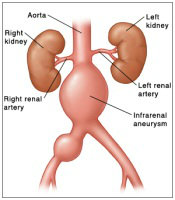Endovascular Aneurysm Repair (EVAR)
The aorta is the largest artery in the body which carries blood around the body. An endovascular aneurysm repair (EVAR) is a minimally invasive procedure which is performed as an alternative to invasive surgery, to treat a thoracic or abdominal aortic aneurysm (AAA).
The wall of the artery may become weak due to the pressure of the blood pumping through. The weakening and the bulging of this artery is called an aortic aneurysm.
